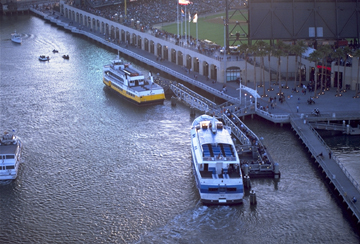Baseball has been Very Ferry Good at Pac
Bell Park
 |
| Scene
from the air of the two new floats made possible by grants from the federal and Port of
San Francisco |
The inaugural season of
baseball at Pac Bell Park is a dream come true for baseball fans. Intoxicated by
a winning team playing in an incomparably beautiful ballpark, few fans, and
fewer still of the public at large, appreciate how important a role ferry
service played in making it all possible.
The San Francisco Giants had
to agree to include a ferry terminal in order to get permission to build the
ballpark to calm fears of traffic gridlock. Port of San Francisco officials,
notably Veronica Sanchez, head of Government Affairs, scared up $2 million
dollars from the Federal Transit Administration and the Port itself kicked in
another half million. These funds were used to install two landing docks for
ferries alongside the Park (called, in maritime circles, "floats").
The second of these floats was installed in August, replacing a temporary float
across Willie McCovey Cove.
The Port was thinking further
ahead than just ballpark service when it went after funding for ferry service to
Pac Bell Park. Importantly, the ferry stop at Pac Bell Park will serve the huge
new Mission Bay development now under construction. Regular commuter service can
be expected in the next few years. The Mission Bay complex will include office,
residential and commercial development and also be home to the University of
California at San Francisco’s Biomedical facilities. UCSF actively supported
the Port in the search for federal dollars to make possible the Pac Bell Park
ferry terminal.
Ferry service to Pac Bell
Park alone has been hugely successful with fans making over 100,000 trips via
ferry to watch the Giants steamroll their way towards a Division championship.
So many people want to go to games by ferry that ferry fleet’s capacity has
been seriously strained. Every major ferry line has new ferryboats on order, in
part because of the demand created by Pac Bell Park.
"We’re just knocked
out by the fantastic reaction we’ve had from fans and ferryriders alike to our
ballpark service", croons Ron Duckhorn, President of the Blue and Gold
fleet which took a leading role in sorting out the complex logistics of meshing
commuter and ballpark service. "Alameda/Oakland, Tiburon, Sausalito: we’re
seeing big and increasing numbers from all our points of service".
The overwhelming public
response to Pac Bell ferry service lends mighty momentum to plans for increased
water transit. With Bay highways near paralysis from overuse and
environmentalists unwilling to budge on expensive new emissions controls, the
demise of the suburban/urban commute paradigm is an actuarial fact. Huge
bureaucracies determined to preserve the flailing status quo, the Metropolitan
Transportation Commission, for example, and the road and car builders it
represents, can no more stand in the way than did the Berlin Wall the fall of
Communism.
The success of Pac Bell Park
points the way to what we shall be experiencing much more and more in the
not-so-distant future: people living in compact waterside communities using safe
and environmentally friendly water transit to commute to work and play. It’s
already a jewel in the crown of the Bay’s maritime operations. Indeed, the
Port of San Francisco is the only US port to claim a major league
baseball team as a tenant. As a result, enormous public attention is being drawn
to all the dynamic activity of the San Francisco waterfront, ferries first and
foremost,
In the best and most
optimistic sense, each joyful trip by a Giants fan to a game is a repudiation of
forty-years of obsessive road and car building and the environmental and social
debacle that resulted. Anyone taking the ferry to a ballgame – or anywhere
else, for that matter – knows that life after cars isn’t only possible: it’s
preferable.